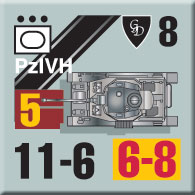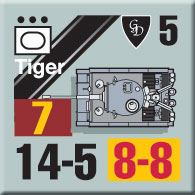Panzer Grenadier Division Grossdeutschland
by Mike Bennighof, Ph.D.
December 2022
 Infantry Regiment Grossdeutschland participated in the 1941 invasion of the Soviet Union, attached to the 46th Motorized Corps in Army Group Center. The regiment fought well, but suffered catastrophic losses in December 1941. As a favored unit, it was withdrawn for re-organization and in the early spring of 1942 was upgraded to a motorized infantry division. Infantry Regiment Grossdeutschland participated in the 1941 invasion of the Soviet Union, attached to the 46th Motorized Corps in Army Group Center. The regiment fought well, but suffered catastrophic losses in December 1941. As a favored unit, it was withdrawn for re-organization and in the early spring of 1942 was upgraded to a motorized infantry division.
By that point, the regiment had relatively few survivors to serve as cadre for the new division – almost all of the personnel were new. As a motorized infantry division, Grossdeutschland would have two infantry regiments, each of three infantry battalions plus a heavy weapons battalion. To support them, the division had a tank battalion and an assault gun battalion, a flak battalion, a motorcycle battalion, an artillery regiment and a combat engineer battalion. Plus a field replacement battalion.
That list doesn’t begin to describe just how much firepower Grossdeutschland wielded compared to standard German Army divisions, an edge that would account for much of the division’s effectiveness (and even greater reputation for effectiveness) over the next three years.
A standard German Army infantry battalion had three rifle companies and a heavy weapons company with anti-tank, infantry gun and engineer platoons, the same as Grossdeutschland. But the Grossdeutschland rifle companies also included mortar and machine gun platoons, plus an additional machine-gun company at the battalion level (with three platoons rather than the usual two). That gave the battalion twice the allotment of machine guns and mortars as the usual motorized infantry battalion.
And there was more. The usual infantry regiment had an infantry gun company and an anti-tank company; a Grossdeutschland regiment had a support battalion with a double-sized infantry gun company plus a light flak company with 20mm guns, a company of self-propelled tank destroyers, and a support company with engineer, signals and motorcycle platoons.
 
And there was still more extra firepower. They typical German panzer division’s artillery regiment had three battalions, two of them of towed guns and one self-propelled. Grossdeutschland had a fourth artillery battalion. The regular army panzer division had an anti-aircraft battalion with three batteries (two of 88mm guns, one of light guns); Grossdeutschland’s battalion had six batteries (three each, heavy and light).
Grossdeutschland participated in the Case Blue offensive in the summer of 1942, reaching the upper Don and helping to capture Voronezh. As a favored unit, Grossdeutschland was withdrawn from combat before becoming too depleted and rested in reserve until the Soviet winter offensives opened. Then the division went north to battle the Soviet Operation Mars, enduring brutal combat in the Luchesa River valley and suffering heavy losses. Unlike the other German units that also bled there, Grossdeutschland left the front lines for another period of rest and refit.
Moving back to the southern front, Grossdeutschland saw action in the Third Battle of Kharkov. Afterwards the division once again pulled out of the front line for re-organization and re-equipment. As a highly favored unit, its very name a mainstay of propaganda efforts, it received such treatment far more often than the usual German Army formation. But with a massive new offensive in the offing, this time the re-fitting had a very definite purpose.
Though now titled “Panzer Grenadier Division Grossdeutschland,” the re-organized division would be much stronger than a standard panzer grenadier division or even panzer division. Like a panzer grenadier division, it had two regiments each of three battalions. In early June 1943, about a month before the Battle of Kursk opened, the division received enough half-track armored personnel carriers to mount the first battalion of each of its motorized infantry regiments – a practice usually confined to well-equipped panzer divisions, and then rarely did a second battalion receive armored carriers.
And that was just the start. A panzer grenadier division usually had either a tank battalion or one of assault guns. Grossdeutschland had one of each, and in the spring of 1943 received a second tank battalion. As if that were not enough, an oversized company of Tiger tanks joined the division as well, expanding to become the tank regiment’s third battalion in the August 1943. A regular panzer division had but two tank battalions, and no assault guns (unless they took the place of tanks).
  
All told, Grossdeutschland’s combat strength probably equaled that of a regular Army panzer division plus a regular Army panzer grenadier division. That sort of weaponry certainly helped Grossdeutschland gain a reputation as an elite unit; Grossdeutschland’s morale and tactical leadership appear to have been very good, but there’s no substitute for firepower.
At Kursk, Grossdeutschland was deployed with 48th Panzer Corps as part of the southern German flank. It suffered heavy casualties in the initial assault, particularly in its Fusilier regiment which became entangled in thick Soviet minefields. The tank regiment, deploying its Tigers at the tip of a giant armored wedge, managed to make some progress but despite all that firepower the Grossdeutschland Division did not do as well as the neighboring 3rd Panzer Division. The division was not involved in the massive tank battle at Prokhorovka.
Afterwards, the division served as a mobile reserve on the central and southern sectors of the Eastern Front. In January 1944 a Panther tank battalion arrived from another division, while one of Grossdeutschland’s went to France to train with the new machines. The rest of the division never had the opportunity to follow, as it continued its “fire brigade” role in the retreat across Ukraine.
From March through July, Grossdeutschland fought in Romania to repel the Soviet invasion, including the two battles of Târgu Frumos in April (the first one) and May (the second one) 1944. Thanks to former division commander Hasso von Manteuffel’s relentless post-war self-promotion, Western armies used the battles as training examples throughout the Cold War. Grossdeutschland had many advantages – firepower, mobility, strong integral artillery support and plentiful tanks – and used these to great effect, repelling the assaults of Soviet formations outnumbering them many times over.
Those battles would be the high-water mark for Grossdeutschland. While SS divisions would be pulled back from the front before becoming too depleted to be easily restored to full combat power, Grossdeutschland remained at the front, though in May after the Second Battle of Târgu Frumos the division received enough armored halftracks to mount all of its infantry.
Grossdeutschland left Romania for East Prussia in late July. That redeployment violated Germany’s agreement to support the defense of Romania, and would be cited by the Romanians a month later when they left the Axis and the war. In East Prussia the division again fought well, but this time rest and replacements were not forthcoming. By the next spring the division was down to about 4,000 men, though a Panzer Corps Grossdeutschland had been created by drafting away some of the original division’s men and formations.
Those remnants were lost fighting around Memel and Pillau in East Prussia in the closing weeks of World War II. A few hundred men made it to Schleswig as part of the large-scale evacuations of soldiers and civilians by sea, where they surrendered to the British; others were taken captive by the Red Army.
We included Grossdeutschland pieces in their own color scheme in Panzer Grenadier: 1940 The Fall of France, and briefly issued a special, limited edition set of pieces for use with Kursk: Burning Tigers (which has many scenarios for the division, but no special pieces). Our Grossdeutschland 1944 book has special pieces for use with Broken Axis, which covers the battles of Târgu Frumos among other actions from the invasion of Romania. The book’s scenarios mostly involve other German and Romanian divisions – we covered most of the interesting Grossdeutschland actions in Broken Axis.
You can order Grossdeutschland 1944 right here.
Sign up for our newsletter right here. Your info will never be sold or transferred; we'll just use it to update you on new games and new offers.
Mike Bennighof is president of Avalanche Press and holds a doctorate in history from Emory University. A Fulbright Scholar and NASA Journalist in Space finalist, he has published a great many books, games and articles on historical subjects; people are saying that some of them are actually good.
He lives in Birmingham, Alabama with his wife, three children, and new puppy. He misses his lizard-hunting Iron Dog, Leopold.
Want to keep Daily Content free of third-party ads? You can send us some love (and cash) through this link right here.
|
